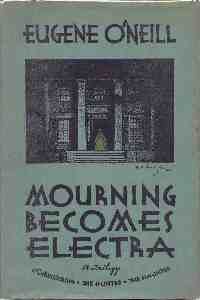Mourning Becomes Electra
| Mourning Becomes Electra | |
|---|---|

1931 Liveright first edition cover
|
|
| Written by | Eugene O'Neill |
| Date premiered | 26 October 1931 |
| Place premiered |
Guild Theatre New York City |
| Original language | English |
| Genre | Drama |
| Setting | 1865, New England |
Mourning Becomes Electra is a play cycle written by American playwright Eugene O'Neill. The play premiered on Broadway at the Guild Theatre on 26 October 1931 where it ran for 150 performances before closing in March 1932. In May 1932, it was revived at the Alvin Theatre (now the Neil Simon Theatre), and in 1972 at the Circle in the Square Theatre.
The story is a retelling of the Oresteia by Aeschylus. The characters parallel characters from the ancient Greek play. For example, Agamemnon from the Oresteia becomes General Ezra Mannon. Clytemnestra becomes Christine, Orestes becomes Orin, Electra becomes Lavinia, Aegisthus becomes Adam Brant, etc. As a Greek tragedy made modern, the play features murder, adultery, incestuous love and revenge, and even a group of townspeople who function as a kind of Greek chorus. Though fate alone guides characters' actions in Greek tragedies, O'Neill's characters have motivations grounded in 1930s-era psychological theory as well. The play can easily be read from a Freudian perspective, paying attention to various characters' Oedipus complexes and Electra complexes.
Mourning Becomes Electra is divided into three plays with themes that correspond to the Oresteia trilogy. Much like Aeschylus' plays Agamemnon, The Libation Bearers and The Eumenides, these three plays by O'Neil are titled Homecoming, The Hunted, and The Haunted. However, these plays are normally not produced individually, but only as part of the larger trilogy. Each of these plays contains four to five acts, with only the first act of The Haunted being divided into actual scenes, and so Mourning Becomes Electra is extraordinarily lengthy for a drama. In production, it is often cut down. Also, because of the large cast size, it is not performed as often as some of O'Neill's other major plays.
...
Wikipedia
